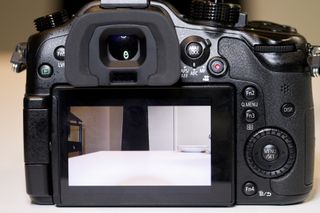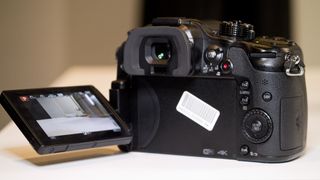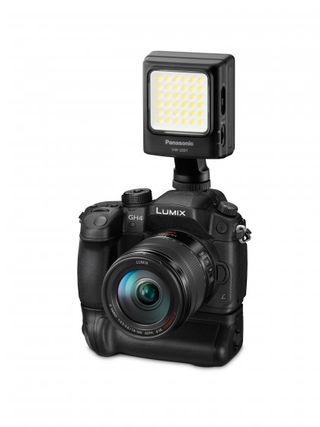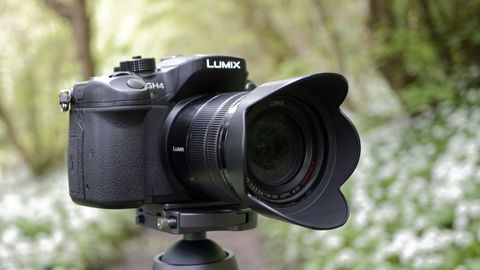Why you can trust TechRadar
There are only a few noticeable differences in the appearance of the GH4 in comparison with the GH3, they are very closely matched in size and weight and have an almost identical control layout.
The eye-cup around the electronic viewfinder (EVF) is slightly larger on the GH4 to offer a little more shade from strong sunlight, for example. There's also a lock button at the centre of the mode dial to prevent it from being knocked out of position. This lock is our preferred type that clicks to lock or unlock so the button doesn't need to be held down when rotating the dial.
There's also a new Time Lapse Shot option on the drive mode dial on the top-plate of the camera. Time lapse recording can be set to start immediately, or it can be delayed by up to 23 hours and 59 minutes. The recording interval can also be set from 1 second to 99 minutes and 59 seconds with a maximum of 9,999 images being possible.
As before, the GH4 has a magnesium alloy body that is dust- and splash-proof. It has the same solid feel as the camera it replaces. However, Panasonic has bolstered the GH4's durability by giving its shutter a life-span of 200,000 cycles, double that of the GH3.

We found that the GH4's 2.359-dot electronic viewfinder (EVF) gives a very clear view with plenty of detail in most situations, but left eye users may come across a few occasions when their eye isn't completely straight towards it, causing some parts of the scene to look soft or slightly distorted.
The 3-inch 1,036,000-dot LCD screen also offers a very clear view and images look great on it as there's a pleasing level of contrast. It's also very responsive to the touch, making it a great way of selecting AF points and other setting options.
Because the screen is on a vari-angle hinge it's useful when composing images at unusual angles in portrait and landscape format, and it encourages more creative shooting. There's also an electronic level that turns from yellow to green when the camera is held level, so you can be sure that the horizon will be on an even keel. There are a few occasions, however, when it would be nice to make the level's indicator line a little more visible than it is.
The arrangement of the button and dial controls on the GH4 is the same as on the GH3 and it all makes good sense. In addition to the exposure and drive mode dials there are buttons on the top-plate to reach the white balance, sensitivity and exposure compensation options.
A switch on the back of the camera also provides a quick and convenient means of selecting single or continuous autofocus or manual focus. In addition, there are five physical buttons that can be customised to access your most commonly used features. However, we found the default options were a good choice.

There are a further five virtual function buttons available on the screen. Two of these have default purposes, but the remaining three are free.
The Quick menu, which by default is accessed by pressing the Fn2 (Function 2) button (also marked Q Menu) also provides a route to a useful collection of features, but even better news is that this can be customised to reach your favourite options.
Although the GH4's control layout is generally good, there is some room for improvement and aspects of the operating system could do with a rethink. It seems strange, for example, that it's possible to shoot in aperture priority mode in most of the Creative Control modes, Miniature Effect being the exception, but the effects are only available via the Creative Control option on the mode dial and exposure has to be adjusted via the menu.
It would be simpler if the Creative Control options were accessible when the mode dial was set to aperture priority (and preferably the other exposure mode options) in the same way as the Photo Styles. After all, both of these feature sets allow raw and JPEG recording simultaneously, and both affect aspects such as colour, contrast and sharpening. It would make more sense to the user if they were accessed via the same route.
Similarly, despite the complexities of achieving 4K movies, the user will find it strange that Full HD options can be accessed in program, aperture priority, shutter priority and manual exposure mode, whereas the 4K recording options can only be accessed when the mode dial is set to Video. Similarly, 4K recording is only possible in video mode.

The GH4 has an NFC chip to enable speedy connection to other NFC enabled devices, but it can also be connected quickly and easily to iOS devices because the screen can display a QR code which conveys all the necessary information for the initial set-up. Panasonic's free Image App enables the GH4 to be controlled remotely by a smartphone or tablet with control over key features and images to be transferred for sharing.

'A whole new generation of displays': researchers develop RGB LED out of miracle material perovskite, paving the way for self sensing, solar powered displays — but its hour-long service life needs to be improved first

Quordle today – hints and answers for Sunday, April 21 (game #818)

NYT Strands today — hints, answers and spangram for Sunday, April 21 (game #49)
